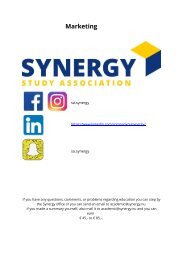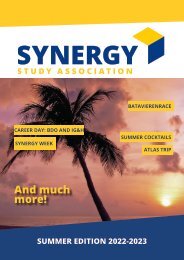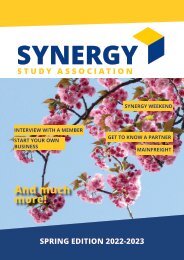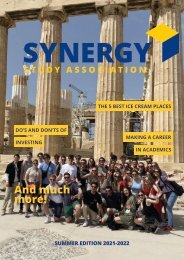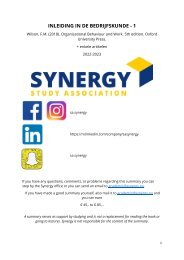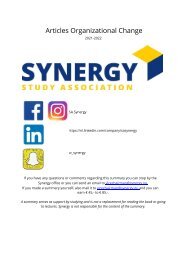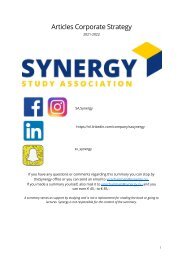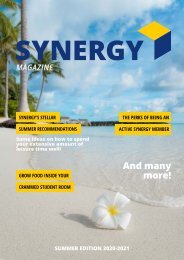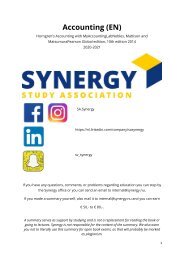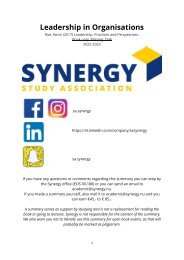You also want an ePaper? Increase the reach of your titles
YUMPU automatically turns print PDFs into web optimized ePapers that Google loves.
eferred to as licenses or permits.<br />
5. Technology-related intangible assets → Technology-related intangible assets relate to<br />
innovations or technological advances. Examples are patented technology <strong>and</strong> trade secrets<br />
granted by a governmental body. A patent gives the holder exclusive right to use, manufacture,<br />
<strong>and</strong> sell a product or process for a period of 20 years without interference or infringement by<br />
others. The two principal kinds of patents are product patents, which cover actual physical<br />
products, <strong>and</strong> process patents, which govern the process of making products.<br />
6. Goodwill → Goodwill is measured as the excess of the cost of the purchase over the fair value<br />
of the identifiable net assets purchased. Goodwill generated internally should not be capitalized<br />
in the accounts. Goodwill is recorded only when an entire business is purchased. To record<br />
goodwill, a company compare the fair value of the net tangible <strong>and</strong> identifiable intangible assets<br />
with the purchase price of the acquired business. The master valuation approach assumes that<br />
goodwill covers all the values that cannot be specifically identified with any identifiable tangible<br />
or intangible asset. Companies that recognize goodwill in a business combination consider it to<br />
have an indefinite life <strong>and</strong> therefore should not amortize it.<br />
In a few cases, the purchaser in a business combination pays less than the fair value of the<br />
identifiable net assets. Such a situation is referred to as a bargain purchase.<br />
An intangible asset is impaired when a company is not able to recover the asset’s carrying<br />
amount either through using it or by selling it. If the carrying amount is higher than the<br />
recoverable amount, the difference is an impairment loss. If the recoverable amount is greater<br />
than the carrying amount, no impairment is recorded.<br />
If there is an indication that an intangible asset is impaired, the company performs an<br />
impairment test: compare the carrying value of the intangible asset to the recoverable amount.<br />
Recall that the recoverable amount is defined as the higher of fair value less costs to sell or valuein-use.<br />
Fair value less costs to sell mean what the asset could be sold for after deducting costs of<br />
disposal. Value-in-use is the present value of cash flows expected from the future use <strong>and</strong><br />
eventual sale of the asset less at the end of its useful life. The impairment loss is the carrying<br />
amount of the asset less the recoverable amount of the impaired asset.<br />
Research <strong>and</strong> development (R&D) costs are not in themselves intangible assets.<br />
Research activities → original <strong>and</strong> planned investigation undertaken with the prospect of gaining<br />
new scientific or technical knowledge <strong>and</strong> underst<strong>and</strong>ing. Examples: laboratory research aimed<br />
at discovery of new knowledge: searching for applications of new research findings.<br />
Development activities: application of research findings or other knowledge to a plan or design<br />
for the production of new or substantially improved materials, devices, products, processes,<br />
systems, or services before the start of commercial production or use. Examples: conceptual<br />
formulation <strong>and</strong> design of possible product or process alternatives; construction of prototypes<br />
<strong>and</strong> operation of pilot plants.<br />
The costs associated with R&D activities <strong>and</strong> the accounting treatments accorded them are as<br />
follows:<br />
1. Materials, equipment <strong>and</strong> facilities. Expense the entire costs, unless the items have alternative<br />
future uses.<br />
2. Personnel<br />
3. Purchased intangibles<br />
4. Contract services<br />
5. Indirect costs<br />
28



